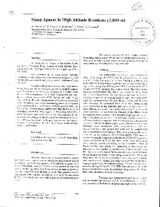Sleep apneas in high altitude residents (3,800 m)

View/
Date
1992Author
Normad, H
Vargas, E
Bordachar, J
Benoit, O
Raynaud, J
Metadata
Show full item recordAbstract
Abstract. The question is: to what extent periodic breathing usually observed in translocated subjects at high altitude affects normal and polycythemic residents of high altitude?
Standard sleep parameters, chest wall movements, temperature of ventilated gas and arterial O₂ saturation (SaO₂) were continuously recorded in 7 normal high-landers ( mean hematocrit: 5l %) and 14 polycythemic high-landers (mean hematocrit: 68%) during one night in La Paz, 3,850 m, Bolivia. The patterns of breathing instability were analysed by two ways: measuring duration of apneas and counting all the oscillations of SaO₂ greater than 1%. Normal and polycythemic highlanders displayed a wide intersubject variability with regard to breathing instability, hence no significant difference in the total number of apneas and oscillations of SaO₂ could be evidenced between the 2 groups. However, the longest apneas and the highest number of oscillations of SaO₂ were found in the polycythemic highlanders.
